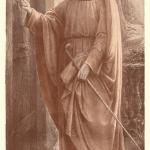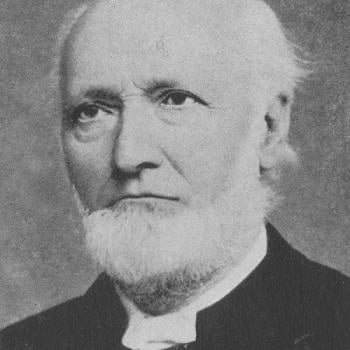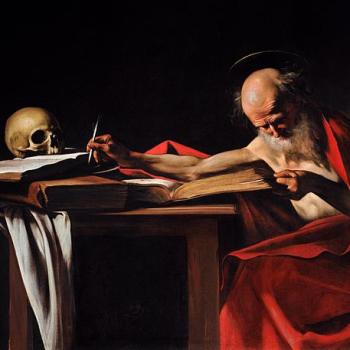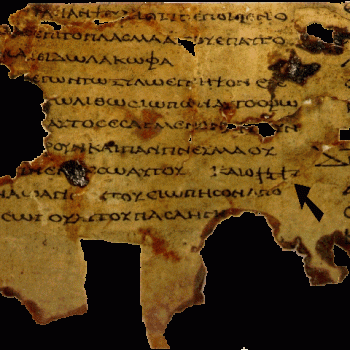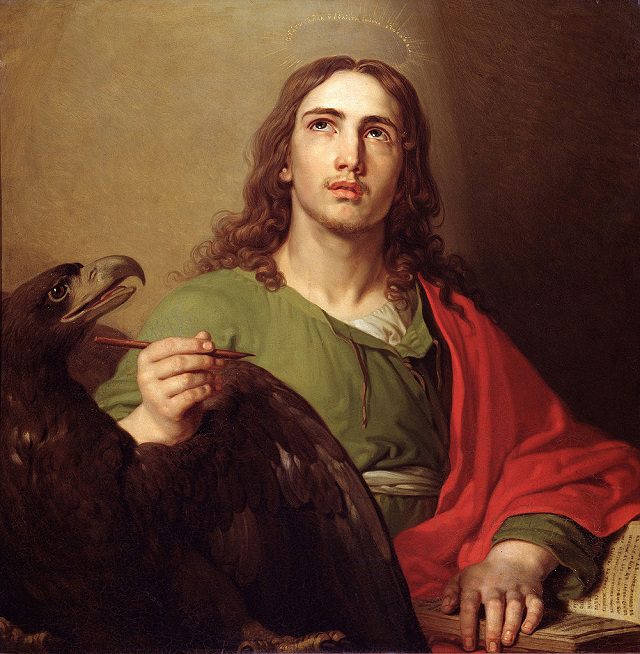
Atheist anti-theist Jonathan M. S. Pearce is the main writer on the blog, A Tippling Philosopher. His “About” page states: “Pearce is a philosopher, author, blogger, public speaker and teacher from Hampshire in the UK. He specialises in philosophy of religion, but likes to turn his hand to science, psychology, politics and anything involved in investigating reality.” His words will be in blue.
*****
This is a reply to the article, The Author of the Gospel of John (9-1-21). Pearce thinks that the apostle John did not write the Gospel that bears his name.
I will be drawing from An Introduction to the New Testament (1st edition, 1992, Grand Rapids, Michigan: Zondervan, by
Douglas J. Moo (b. 1950) received his Ph.D from the University of St. Andrews and is professor of New Testament, Wheaton College Graduate School. He has written or edited about fifteen books.
Leon Morris (1914-2006) was ordained to the Anglican ministry in 1938. He earned a Master of Theology from from the University of London and his PhD at the University of Cambridge. He served as principal of Ridley College in Melbourne (1964-1979), Australia and Visiting Professor of New Testament at Trinity Evangelical Divinity School. He has written or edited about seventeen books.
Pearce can smugly say, I suppose, that these scholars are “dumbbells” and “troglodytes” because they aren’t liberal Christians. He says a lot of clueless and absurd things, I’m afraid. I haven’t been able to stop him with mere facts and contrary reasoning.
[1] . . . the key for Christians is to attempt to show that this so-called “Beloved Disciple” is John himself.
Carson et al devote no less than six-and-a-half pages to the question of the identity of the “beloved disciple” alone. All agree that this is a key question. So let’s debate it. Pearce provides no argument. I will present numerous ones from Carson et al. Let the reader decide after hearing more than one jaded point of view (and baldly and inadequately stated at that, as if no one could possibly doubt it, based on Pearce’s one-sentence supposed “argument”).
1) He was at the Last Supper, and so was one of the twelve disciples (Jn 13:23). According to the synoptics, they were the only ones there.
2) He is repeatedly distinguished from Peter (13:23-24; 20:2-9; 21:20).
3) He is obviously not any of the other disciples named in John: Andrew (1:40), Philip (1:43-44), Nathanael [aka Bartholomew] (1:44-49), Thomas (11:16), Judas Iscariot (6:71), and Jude / Thaddeus (14:22). That leaves five disciples: one of whom he was. He is one of seven disciples who go fishing (Jn 21:1-3, 7). The logical possibility is that he is one of the sons of Zebedee (James and John, as we know from Mt 4:21; 10:2; Mk 1:19; 3:17; 10:35; Lk 5:10) or one of the two unnamed disciples (21:2). He cannot be James, because he was the first disciple martyred (in c. 44: cf. Acts 12:1-2). That leaves John, James the Lesser, Matthew, or Simon the Zealot as the four remaining possibilities, by straightforward deduction.
4) The “beloved disciple” is constantly hanging around Peter. The Gospel of Mark (Mk 5:37; 9:2; 14:33 ff.), Acts (3:1-4:23; 8:15-25), and Galatians 2:9 link Peter and John (Mk 5:37; 9:2; 14:33 ff.).
5) Carson et al state: “the traditional reason seems most plausible: the beloved disciple is none other than John, and he deliberately avoids using his personal name” . . . the internal evidence is very strong, though not beyond dispute, that the beloved disciple is John the apostle, the son of Zebedee. What, then, is the relationship between the beloved disciple and the fourth evangelist? The traditional answer is that they are one and the same. Today this is commonly denied.” (pp. 145, 147-148).
6) It’s argued that no Christian would describe himself as loved by Jesus, because this smacks of pride and exclusivism. But this doesn’t follow. St. Paul wrote that Jesus “loved me and gave himself for me” (Gal 2:20, RSV).
7) Carson et al observe: “if the evangelist is someone other than John the son of Zebedee, his failure to mention the apostle John by name, when he mentions so many others, is even more difficult to explain” (p. 149). And it’s difficult in light of the obvious importance of John in the synoptics. In my first book, A Biblical Defense of Catholicism, I noted (p. 236) that “Peter’s name is mentioned more often than all the other disciples put together: 191 times . . . John is next in frequency, with only forty-eight appearances, and Peter is present fifty percent of the time we find John in the Bible.”
I also noted that I included 13 instances of “the disciple whom Jesus loved” etc. and five from Revelation, in John’s tally. If we omit those, it still adds up to 30 mentions in the three synoptic Gospels. Fulton Sheen estimated that the disciples besides Peter were mentioned 130 times. Thus, John would make up 23% of that total, even though he is one of eleven disciples besides Peter. Thus out of 321 references to disciples, Peter made up 60%. John is second with 9%, 11%, or 15%: depending on what the figure includes. No one else is remotely close even to John’s total. All this makes it quite implausible that the author of John would never mention John the disciple if in fact he were someone other than him.
[1] John admits that his account is hearsay – non-eyewitness – by saying in verse 21: 20-24 that it represents a compilation of the testimony of the oft-debated and unnamed “Beloved Disciple” of Jesus. . . .
[2] The author never declares himself as the Beloved Disciple.
John 21:20-24 certainly seems to assert (at the very least it is an altogether reasonable interpretation) that the “beloved disciple” is the (self-understood) author of John:
John 21:20-24 Peter turned and saw following them the disciple whom Jesus loved, who had lain close to his breast at the supper and had said, “Lord, who is it that is going to betray you?” [21] When Peter saw him, he said to Jesus, “Lord, what about this man?” [22] Jesus said to him, “If it is my will that he remain until I come, what is that to you? Follow me!” [23] The saying spread abroad among the brethren that this disciple was not to die; yet Jesus did not say to him that he was not to die, but, “If it is my will that he remain until I come, what is that to you?” [24] This is the disciple who is bearing witness to these things, and who has written these things; and we know that his testimony is true.
[3] The Gospel has dependency on the previous Gospels.
Indeed. But so what? No one disagrees with that.
[6] The author speaks in the third person, including in John 21: 24 where he says “we know that his testimony is true”.
[7] Further to the above, the author is included in the “we” who knows that “his” (ie, the Beloved Disciple’s) testimony is true. Thus, grammatically speaking, the claim that John is the Beloved Disciple, as per tradition, is problematic. When the Gospel does use “I”, oddly, it is in opposition to the “Beloved Disciple” references in the third person (such confusion leads many to believe it was written as a group effort, or with many revisions).
[8] New Testament scholar Robert Kysar states concerning the authorship of the Gospel of John (my emphasis): “The supposition that the author was one and the same with the beloved disciple is often advanced as a means of insuring that the evangelist did witness Jesus’ ministry. Two other passages are advanced as evidence of the same – 19:35 and 21:24. But both falter under close scrutiny. 19:35 does not claim that the author was the one who witnessed the scene but only that the scene is related on the sound basis of eyewitness. 21:24 is part of the appendix of the gospel and should not be assumed to have come from the same hand as that responsible for the body of the gospel. Neither of these passages, therefore, persuades many Johannine scholars that the author claims eyewitness status.” The Anchor Bible Dictionary, vol. 3, p. 919-920)
Use of the third person to refer to oneself is what is known as “illeism”. A book devoted to this very topic stated:
[T]his phenomenon occurs frequently in the Bible and, in the vast majority of its use in direct discourse (over 80 percent), it is used by Yahweh in the Old Testament (OT) and Jesus in the Gospels.
That means 20% of the time this technique is used by mere creatures (like the author of John). Jesus habitually did this in referring to Himself as “the Son of Man.”
Bible scholar E. W. Bullinger, in his 1104-page volume, Figures of Speech Used in the Bible (London: 1898; see the online complete book link too, and the paginated Internet Archive version), dealt with this literary technique, under the category of “Heterosis of Person and Number (Verbs). Heterosis as a larger category takes up 25 pages of his book (pp. 510-534). But as for person and number he documents massive biblical use of this figure of speech. Note John 21:24 under category number 4:
In order to make what is said more emphatic, Hebrew idiom sometimes changes the number and person of the verb. In most of these cases the figure is correctly rendered in the A.V. [Note: The Authorized Version, or current Text of our English Bible, 1611.] , so that we need only give a few examples which are there passed over.
1. The First Person for the Third
Ecclesiastes 3:18.-“I said in my heart according to the reasoning of the sons of men”: i.e., according to the reasoning of man, or human reasoning: i.e., man says in his heart.
In Romans 7:1-25, Paul, though speaking in the first person, is saying what is true of all who share his experience: and not merely speaking of his own case as being peculiar or different from others.
Romans 10:18.-“But I say.” Who says it? David! But by the Holy Spirit what David said is now repeated by Paul in the first person.
2. The Second Person for the Third
Isaiah 1:29.-“They shall be ashamed for the oaks which ye (i.e., they) have desired,” etc.
For they desired them, of course: yet the persons addressed were equally guilty and are thus by the sudden change of persons charged with the same sin.
Isaiah 42:20.-“Seeing many things, but thou observest not”: (i.e., he observes not) as in the rest of the verse.
Jeremiah 29:19.-“But ye (i.e., they) would not hear.”
Galatians 6:1.-“Ye that are spiritual restore such an one, in the spirit of meekness, considering thyself (instead of yourselves).” This is in order to emphasize the fact that those who are thus addressed stand each in the same individual danger.
3. The Third person for the First or Second
Genesis 49:4.-“Because thou wentest up to thy father’s bed; then defiledst thou it: he went (i.e., thou wentest) up to my couch.”
Isaiah 54:1.-Here the third person is rendered correctly in A.V. [Note: The Authorized Version, or current Text of our English Bible, 1611.] by the second.
Lamentations 3:1.-“I am the man, he hath (i.e., I have) seen affliction.”
Micah 7:18.-Here we have “his” inheritance, after the address “like thee.”
4. The Plural for the Singular
Genesis 29:27.-“Fulfil her week, and we (i.e., I) will give thee this also for thy service.”
Numbers 22:6.-“Peradventure I shall prevail, that we (i.e., I) may smite them.”
2 Samuel 16:20.-“Then said Absalom to Ahithophel, Give counsel among you What shall we (i.e., I) do?”
Job 18:2.-“How long will it be ere ye (i.e., thou) make an end of words? mark, and afterwards we (i.e., I) will speak.”
Daniel 2:36.-“This is the dream; and we (i.e., I) will tell the interpretation thereof.”
Mark 4:30.-“Whereunto shall we (i.e., I) liken the kingdom of God?”
John 3:11.-“We (i.e., I) speak that we (i.e., I) know, and testify that we (i.e., I) have seen; and ye receive not our (i.e., my) witness.”
John 21:24.-“And we (i.e., I) know that his testimony is true.”
Romans 1:5.-“By whom we (i.e., I, Paul) have received grace and apostleship.” (See also Hendiadys).
1 Timothy 2:15.-“She will be saved through the child-bearing if they (i.e., Eve and all her daughters) abide in faith,” etc.
5. The Singular for the Plural
Numbers 32:25.-“Spake” is (sing) “he spake”: i.e., the tribe as composed of the children of Gad,” etc. It is put for the plural, “they spake”; and it should really be “they spake” (viz., the children of Gad and the children of Reuben), according to the Sevir. This extra-official reading is the Textual reading in several MSS.; in the Samaritan Text, in the Targums of Jonathan and Onkelos, the Septuagint, the Syriac, and the Vulgate. See the note in Dr. Ginsburg’s Hebrew Bible. So 1 Samuel 16:4 : i.e., one particular elder spoke for all. But the sing. [Note: The Singular Number.] is put for the plural: for here, again, according to the note in Dr. Ginsburg’s Text, the verb should be in the plural. This is not only the reading according to the Sevir, but it is in the Text of many MSS., the Editio princeps of the Prophets (Soncino, 1485-6), the first edition of the Hebrew Bible (1488), the Targum, the LXX. [Note: The Septuagint Version (325 b.c.).] Syriac, and the Vulgate. (pp. 524-525; my italics for the subtitles)
[12] The Gospel is a work of sophisticated Greek and well-developed theology – almost impossible to have come from an uneducated fisherman, for example. Confusing matters, John 21:24 states “This is the disciple who is bearing witness about these things, and who has written these things, and we know that his testimony is true.” This makes John the son of Zebedee, a Galilean fisherman, unlikely to be the author. The literacy level of the original Twelve seems to preclude any of them realistically being authors of the Gospels.
This is untrue. Carson et al refute it:
Although in the past it has been argued that a Palestinian could not write such fluent Greek, the argument no longer stands. There is now a powerful consensus [i.e., in 1992: 29 years ago] that at least in Galilee, and perhaps elsewhere in first-century Palestine, the populace was at least bilingual. . . . if John lived abroad for years before writing [in Ephesus, as tradition attests], he had ample time to practice his Greek. Moreover, although the Greek of John’s gospel is reasonably competent, it is not elegant, and it betrays a fair number of Semitizing “enhancements.” . . . This sort of evidence is perfectly consonant with what little we know of the background of John the son of Zebedee. (p. 147)
Now we shall examine what Pearce ignored: external evidence for the book being written by St. John:
1) The first writer to unquestionably cite the fourth Gospel and attribute it to John is Theophilus of Antioch (c. AD 181) (see Carson et al, 139).
2) Before that date several writers, including Tatian (c. 120-c. 180), Claudius Apollinaris (2nd century), and Athenagoras (c. 133-c. 190), clearly quote the Gospel as authoritative.
3) Polycarp (d. 156) knew St. Irenaeus (130-202), and the latter recalled talking to him about Polycarp’s friendship with St. John (Eusebius, History of the Church: 6.20.5-6).
4) St. Irenaeus wrote: “John the disciple of the Lord, who leaned back on his breast, published the Gospel while he was resident at Ephesus in Asia” (Against Heresies, II: 1:2).
5) According to Eusebius (History of the Church, 6.14.7), Clement of Alexandria (c. 150-c. 215) stated that John wrote “a spiritual Gospel”.
6) Carson et al conclude:
Certainly from the end of the second century on, there is virtual agreement in the church as to the authority, canonicity, and authorship of the gospel of John. . . . even if we must turn to Irenaeus, toward the end of the second century, to find one of the first totally unambiguous witnesses, his personal connection with Polycarp, who knew John, means the distance in terms of personal memories is not very great. . . .
[A] large majority of contemporary scholars reject [Johannine authorship]. As we shall see, much of their argumentation turns on their reading of the internal evidence. Nevertheless, it requires their virtual dismissal of the external evidence. This is particularly regrettable. Most historians of antiquity, other than New Testament scholars, could not so easily set aside evidence as plentiful and as uniform. (p. 141).
See also:
“Busting Seven Arguments Against the Traditional Authorship of John” (Erik Manning, 8-15-20)
“The Authorship of John’s Gospel. An Assessment of the Recent Debates” (Oladotun Paul, 2019)
“Who Wrote John’s Gospel?” (Andreas Köstenberger, Biblical Foundations, 2008)
“The Circumstantial Case For John’s Authorship” (J. Warner Wallace, Cold-Case Christianity, 11-18-16)
“Authorship of the Gospel of John” (Andrew Huff, 10-22-16)
***
Photo credit: St John the Evangelist (1804-1809), by Vladimir Borovikovsky (1757-1825) [public domain / Wikimedia Commons]
***
Summary: Atheist Jonathan MS Pearce sez John didn’t write the Gospel of John, citing skeptics of the traditional view. I argue the contrary from extensive internal and external historical evidence.


